Predicting Building Energy Demand and Retrofit Potentials Using New Climatic Stress Indices and Curves
Abstract
:1. Introduction
Paper Position
2. Materials and Methods
2.1. Degree-Days Approach: HDD and CDD
- zone A, from 0 to 600 heating degree days (HDDs); the heating season is from 1 December to 15 March, and the heating system can be switched on for 6 h per day;
- zone B, from 601 to 900 HDDs; the heating season is from 1 December to 31 March and the system can be switched on for 8 h per day;
- zone C, from 901 to 1400 HDDs; the heating season is from 15 November to 31 March, and the system can be switched on for 10 h per day;
- zone D, from 1401 to 2100 HDDs; the heating season is from 1 November to 15 April, and the system can be switched on for 12 h per day;
- zone E, from 2101 to 3000 HDDs; the heating season is from 15 October to 15 April, and the system can be switched on for 14 h per day;
- zone F, HDDs higher than 3000; there are no limits to heating operation.
2.2. Proposed Novel Approach: HSI, CSI and YCSI
2.3. SLABE and Optimization of HSI, CSI and YCSI
- thermal energy demand for space heating (TEDh) as concerns HSI;
- thermal energy demand for space cooling (TEDc) as concerns CSI;
- total thermal energy demand for space conditioning (TED = TEDc + TEDh) as concerns YCSI.
- for HSI, the decision variables are Tb, Twinter and the polynomial order (1st or 2nd) of the regression with TEDh: both temperature values vary in the range 10–20 °C, with a step of 1 °C;
- for CSI, the decision variables are Tb, Tsummer and the polynomial order (1st or 2nd) of the regression with TEDc: both temperature values vary in the range 15–24 °C, with a step of 1 °C;
- for YCSI, the expression type, i.e., Equation (4) or Equation (5), and for the latter the coefficients a1 and a2, which vary between 0 and 1 with a step of 0.05; in both equations, the achieved optimal expressions of HSI and CSI are used.
2.3.1. As-Built Scenario (S.1)
2.3.2. Retrofit Scenarios (S.2)
- S.1bis: it is similar to S.1, but with the heating set-point temperature (i23) reduced by 1 °C and the cooling set-point temperature (i26) increased by 1 °C for energy efficiency reasons;
- S.2w: it considers the insulation of external walls, thus modifying the variable i13 to achieve the U-value defined by the law in force [22] depending on the climatic zone;
- S.2r: it considers the insulation of the roof, thus modifying the variable i17 to achieve the U-value defined by the law in force [22] depending on the climatic zone;
- S.2win: it considers the replacement of the windows (in terms of both frame and glass), thus modifying the variable i22, with double-glazed argon-filled low-emissive windows with PVC frames, U = 1.40 W/m2K and SHGC = 0.56, complying with the Italian law in force [22] for all climatic zones;
- S.2wr: it considers the insulation of both external walls and the roof;
- S.2wwin: it considers the replacement of the windows and the insulation of external walls;
- S.2rwin: it considers the replacement of the windows and the insulation of the roof;
- S.2all: it considers the replacement of the windows and the insulation of both the external walls and the roof, thus modifying the variables i22, i13 and i17.
2.4. Testing Case Study: An Existing Building
- Perimetral walls in tuff blocks: U = 0.66 W/m2K at the ground floor, U = 0.87 W/m2K at the first and second floors, and U = 1.13 W/m2K at the top floor;
- Inter-floor slab in masonry: U = 1.20 W/m2K;
- Ground floor as crawl space: U = 1.61 W/m2K;
- Attic floor in masonry: U = 0.98 W/m2K;
- Sloping roof with terracotta tiles: U = 1.88 W/m2K;
- Double-glazed windows air-filled with pine wood frames: U = 2.81 W/m2K.
3. Results and Discussion
3.1. Limits of the Classical HDD Approach
3.2. HSI, CSI and YCSI Polynomial Regressions
- A 2nd order polynomial regression;
- Base temperature for degree-day assessment: Tb = 17 °C;
- Temperature for the start of the heating season: Twinter = 17 °C.
- A 2nd order polynomial regression;
- Base temperature for degree-day assessment: Tb = 22 °C;
- Temperature for the start of the cooling season: Tsummer = 19 °C.
3.2.1. As-Built (S.1) and Retrofit (S.2) Scenarios: A Focus on TED
- on average, not all retrofit measures can cause a reduction in TEDc because they are mainly focused on the improvement of envelope performance in the heating season without considering dynamic parameters such as thermal inertia;
- the group with the highest TEDc values leads to an increase in cooling demand with respect to the as-built scenario since it describes the behavior of a thermally insulated building less able to release the thermal energy stored due to solar and internal gains;
- in particular, the thermal insulation of the building envelope can cause a significant increase in TEDc because of the phenomenon of summer overheating, which can be critical in thermally insulated buildings;
- among all scenarios, the greatest energy savings can be achieved by increasing the cooling set-point temperature, thereby acting on the cooling system management, even if thermal comfort is clearly penalized (S.1bis).
3.2.2. As-Built (S.1) and Retrofit (S.2) Scenarios: A Focus on PEC
3.3. Testing of the New Approach for an Existing Building Not Belonging to the RBS
4. Conclusions
- The classical approach of DDs (degree days) is not completely reliable to predict building energy needs since solar radiation is not considered. Thus, new climatic stress indices are introduced: the heating stress index (HSI), the cooling stress index (CSI) and the yearly climatic stress index (YCSI), which are determined considering the sol–air temperature. For the HSI and CSI expressions, the decision variables are as follows: Tb (base temperature for DD assessment), Twinter or Tsummer, respectively (i.e., the temperatures for the starting of the heating and cooling seasons), and the order of the polynomial in the regression with TEDh and TEDc. The aim is to maximize the coefficient of determination R2 between EnergyPlus results and the predictions of the climatic stress curves. This optimization is carried out using brute-force search by varying the integer variables in defined ranges. Two expressions of YCSI are evaluated as functions of HSI and CSI. The optimal results provide regressions of the 2nd order. HSI is characterized by Tb and Twinter both equal to 17 °C, CSI by Tb equal to 22 °C and Tsummer equal to 19 °C. The best YCSI expression is as follows:
- This result is an evolution of what was achieved in [21], where only the heating stress index was considered. The YCSI is a novelty in the state of the art.
- The climatic stress curves describe the building stock for 63 Italian climatic locations in the as-built scenario and in eight retrofit scenarios. For these curves, the determination coefficient (R2) results are very close to one, thus defining a quite reliable tool to predict thermal energy demand and primary energy consumption. A similar approach to investigating representative building clusters has been developed in [20], which, however, does not refer to the residential sector and does not provide climatic stress curves.
- To evaluate the goodness of the novel approach, an existing building whose energy performance is simulated with another software, i.e., TerMUS Plus® v.1, is investigated. Thus, a comparison between the novel approach and TerMUS Plus® v.1 is performed. The cv(RMSE) as well as the MAPE (mean absolute percentage error) assume acceptable values (lower than 28% and 22%, respectively) according to [36,37], considering the simple model defined and the fact that the testing case study does not belong to the RBS used to generate the climatic stress curves.
- The climatic stress curves can also be used to assess the energy efficiency and cost-effectiveness of retrofit solutions as well as their resilience to climate change.
Author Contributions
Funding
Data Availability Statement
Conflicts of Interest
References
- United Nations Environment Programme. 2021 Global Status Report for Buildings and Construction: Towards a Zero-Emission, Efficient and Resilient Buildings and Construction Sector (Nairobi); United Nations Environment Programme: Nairobi, Kenya, 2021. [Google Scholar]
- United Nations Department of Economic and Social Affairs, Population Division. World Population Prospects 2022: Summary of Results; UNDESA: New York, NY, USA, 2022; Available online: https://www.odyssee-mure.eu/publications/policy-brief/buildings-energy-efficiency-trends.pdf (accessed on 6 June 2023).
- Rousselot, M.; Pinto Da Rocha, F. Energy Efficiency Trends in Buildings in the EU, Policy Brief June 2021. ODYSSEE-MURE Proj. 2021. Available online: http://www.odysseeindicators.org/publications/PDF/Buildings-brochure-2012 (accessed on 6 June 2023).
- Ascione, F.; De Masi, R.F.; Mastellone, M.; Ruggiero, S.; Vanoli, G.P. Improving the building stock sustainability in European Countries: A focus on the Italian case. J. Clean. Prod. 2022, 365, 132699. [Google Scholar] [CrossRef]
- Population Housing Census. Available online: http://dati-censimentopopolazione.istat.it/Index.aspx?lang=en&SubSessionId=9d62b83e-75a2-43a0-abc4-372728b3ed25&themetreeid=16 (accessed on 22 May 2023).
- EU Directive 2018/844 of the European Parliament and of the Council of 30 May. Available online: https://eur-lex.europa.eu/legal-content/IT/TXT/?uri=CELEX%3A32018L0844 (accessed on 22 May 2023).
- IEA. Energy Efficiency 2018: Analysis and Outlooks to 2040; IEA: Paris, France, 2018. [Google Scholar] [CrossRef]
- Makhmalbaf, A.; Srivastava, V.; Wang, N. Simulation-based weather normalization approach to study the impact of weather on energy use of buildings in the US. In Proceedings of the 13th Conference of International Building Performance Simulation Association, Chambery, France, 26–28 August 2013; pp. 1436–1444. [Google Scholar]
- Butche, K. Degree-Days: Theory and Application; The Chartered Institution of Building Services Engineers, CIBSE: London, UK, 2006. [Google Scholar]
- Walsh, A.; Cóstola, D.; Labaki, L.C. Validation of the climatic zoning defined by ASHRAE standard 169-2013. Energy Policy 2019, 135, 111016. [Google Scholar] [CrossRef]
- De Rosa, M.; Bianco, V.; Scarpa, F.; Tagliafico, L.A. Heating and cooling building energy demand evaluation; a simplified model and a modified degree days approach. Appl. Energy 2014, 128, 217–229. [Google Scholar] [CrossRef]
- Kohler, M.; Blond, N.; Clappier, A. A city scale degree-day method to assess building space heating energy demands in Strasbourg Eurometropolis (France). Appl. Energy 2016, 184, 40–54. [Google Scholar] [CrossRef]
- Christenson, M.; Manz, H.; Gyalistras, D. Climate warming impact on degree-days and building energy demand in Switzerland. Energy Convers. Manag. 2006, 47, 671–686. [Google Scholar] [CrossRef]
- Park, J.S.; Sohn, J.Y.; Lee, S.M.; Sung, M.K. Prediction of indoor sol-air temperature in an atrium space with a vertical distribution. In Proceedings of the Healthy Buildings 7th International Conference, Singapore, 7–11 December 2003; National University of Singapore: Singapore, 2003. [Google Scholar]
- Salmerón, J.M.; Álvarez, S.; Molina, J.L.; Ruiz, A.; Sánchez, F.J. Tightening the energy consumptions of buildings depending on their typology and on Climate Severity Indexes. Energy Build. 2013, 58, 372–377. [Google Scholar] [CrossRef]
- Ciulla, G.; D’Amico, A. Building energy performance forecasting: A multiple linear regression approach. Appl. Energy 2019, 253, 113500. [Google Scholar] [CrossRef]
- Neto, A.H.; Fiorelli, F.A.S. Comparison between detailed model simulation and artificial neural network for forecasting building energy consumption. Energy Build. 2008, 40, 2169–2176. [Google Scholar] [CrossRef]
- Andric, I.; Al-Ghamdi, S.G. Climate change implications for environmental performance of residential building energy use: The case of Qatar. Energy Rep. 2020, 6, 587–592. [Google Scholar] [CrossRef]
- Mazzaferro, L.; Machado, R.M.; Melo, A.P.; Lamberts, R. Do we need building performance data to propose a climatic zoning for building energy efficiency regulations? Energy Build. 2020, 225, 110303. [Google Scholar] [CrossRef]
- Mauro, G.M.; Hamdy, M.; Vanoli, G.P.; Bianco, N.; Hensen, J.L. A new methodology for investigating the cost-optimality of energy retrofitting a building category. Energy Build. 2015, 107, 456–478. [Google Scholar] [CrossRef]
- Ascione, F.; Bianco, N.; Mauro, G.M.; Napolitano, D.F.; Vanoli, G.P. Building heating demand vs climate: Deep insights to achieve a novel heating stress index and climatic stress curves. J. Clean. Prod. 2021, 296, 126616. [Google Scholar] [CrossRef]
- DECRETO 26 Giugno 2015. Applicazione Delle Metodologie di Calcolo Delle Prestazioni Energetiche e Definizione Delle Prescrizioni e Dei Requisiti Minimi Degli Edifici; Ministero Dello Sviluppo Economic: Rome, Italy, 2015. (In Italian)
- Decreto del Presidente Della Repubblica 26 Agosto 1993, n. 412. (In Italian). Available online: http://www.decaaced.eu/download/normative/Normative%20Stanziale/DPR%20412%2026%20agosto%201993.pdf (accessed on 1 June 2023).
- UNI 10349-3:2016; UNI Ente Italiano di Normazione—Riscaldamento e Raffrescamento Degli Edifici—Dati Climatici—Parte 3: Differenze di Temperatura Cumulate (Gradi Giorno) ed Altri Indici Sintetici. UNI: Cedar Falls, IA, USA, 2016. (In Italian)
- D.P.R. 1052/1977; Regolamento di Esecuzione Alla Legge 30 Aprile 1976, n. 373, Relativa al Consumo Energetico per Usi Termici Negli Edifici. UNI Ente Italiano di Normazione: Milan, Italy, 1977. (In Italian)
- UNI 6946/2018; UNI Ente Italiano di Normazione—Componenti ed Elementi per Edilizia—Resistenza Termica e Trasmittanza Termica. Metodi di Calcolo: Rome, Italy, 2018. (In Italian)
- UNI 7357/1974; UNI Ente Italiano di Normazione—Calcolo del Fabbisogno Termico Per il Riscaldamento di Edifici. UNI: Cedar Falls, IA, USA, 1974. (In Italian)
- Erbs, D.G.; Klein, S.A.; Beckman, W.A. Sol-air heating and cooling degree-days. Sol. Energy 1984, 33, 605–612. [Google Scholar] [CrossRef]
- Ascione, F.; Bianco, N.; Iovane, T.; Mastellone, M.; Mauro, G.M. Conceptualization, development and validation of EMAR: A user-friendly tool for accurate energy simulations of residential buildings via few numerical inputs. J. Build. Eng. 2021, 44, 102647. [Google Scholar] [CrossRef]
- Ballarini, I.; Corgnati, S.P.; Corrado, V. Use of reference buildings to assess the energy saving potentials of the residential building stock: The experience of TABULA project. Energy Policy 2014, 68, 273–284. [Google Scholar] [CrossRef]
- Corrado, V.; Ballarini, I.; Corgnati, S.P. National Scientific Report on the TABULA Activities in Italy; Dipartimento di Energetica, Gruppo di Ricerca TEBE, Politecnico di Torino: Torino, Italy, 2012; Available online: https://pdfs.semanticscholar.org/fe18/24faf12cc33e9b6135c1416ee33f49a6704e.pdf (accessed on 26 May 2023).
- Canale, L.; De Monaco, M.; Di Pietra, B.; Puglisi, G.; Ficco, G.; Bertini, I.; Dell’Isola, M. Estimating the smart readiness indicator in the italian residential building stock in different scenarios. Energies 2021, 14, 6442. [Google Scholar] [CrossRef]
- Carli, R.; Dotoli, M.; Pellegrino, R.; Ranieri, L. Using multi-objective optimization for the integrated energy efficiency improvement of a smart city public buildings’ portfolio. In Proceedings of the 2015 IEEE International Conference on Automation Science and Engineering (CASE), Gothenburg, Sweden, 24–28 August 2015; pp. 21–26. [Google Scholar]
- Mela, K.; Tiainen, T.; Heinisuo, M. Comparative study of multiple criteria decision making methods for building design. Adv. Eng. Inform. 2012, 26, 716–726. [Google Scholar] [CrossRef]
- EnergyPlus Weather Data. Available online: https://energyplus.net/weather (accessed on 26 May 2023).
- ASHRAE. Measurement of Energy, Demand and Water Savings—Guidelines 14; ASHRAE: Atlanta, GA, USA, 2014. [Google Scholar]
- Swanson, D.A. On the relationship among values of the same summary measure of error when used across multiple characteristics at the same point in time: An examination of MALPE and MAPE. Rev. Econ. Financ. 2015, 5. Available online: https://escholarship.org/content/qt1f71t3x9/qt1f71t3x9.pdf (accessed on 1 June 2023).
- Dai, X.; Cheng, S.; Chong, A. Deciphering optimal mixed-mode ventilation in the tropics using reinforcement learning with explainable artificial intelligence. Energy Build. 2023, 278, 112629. [Google Scholar] [CrossRef]
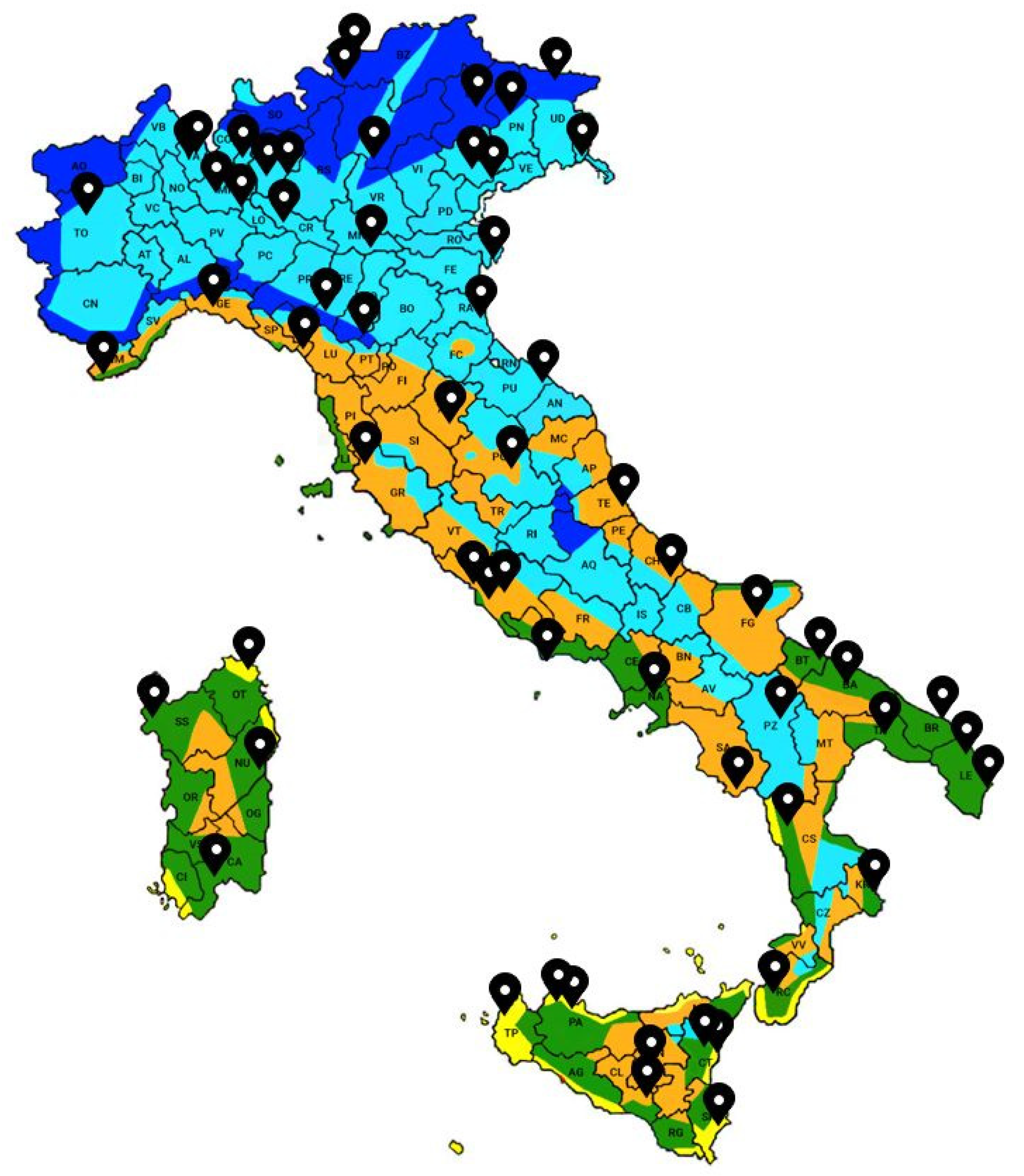

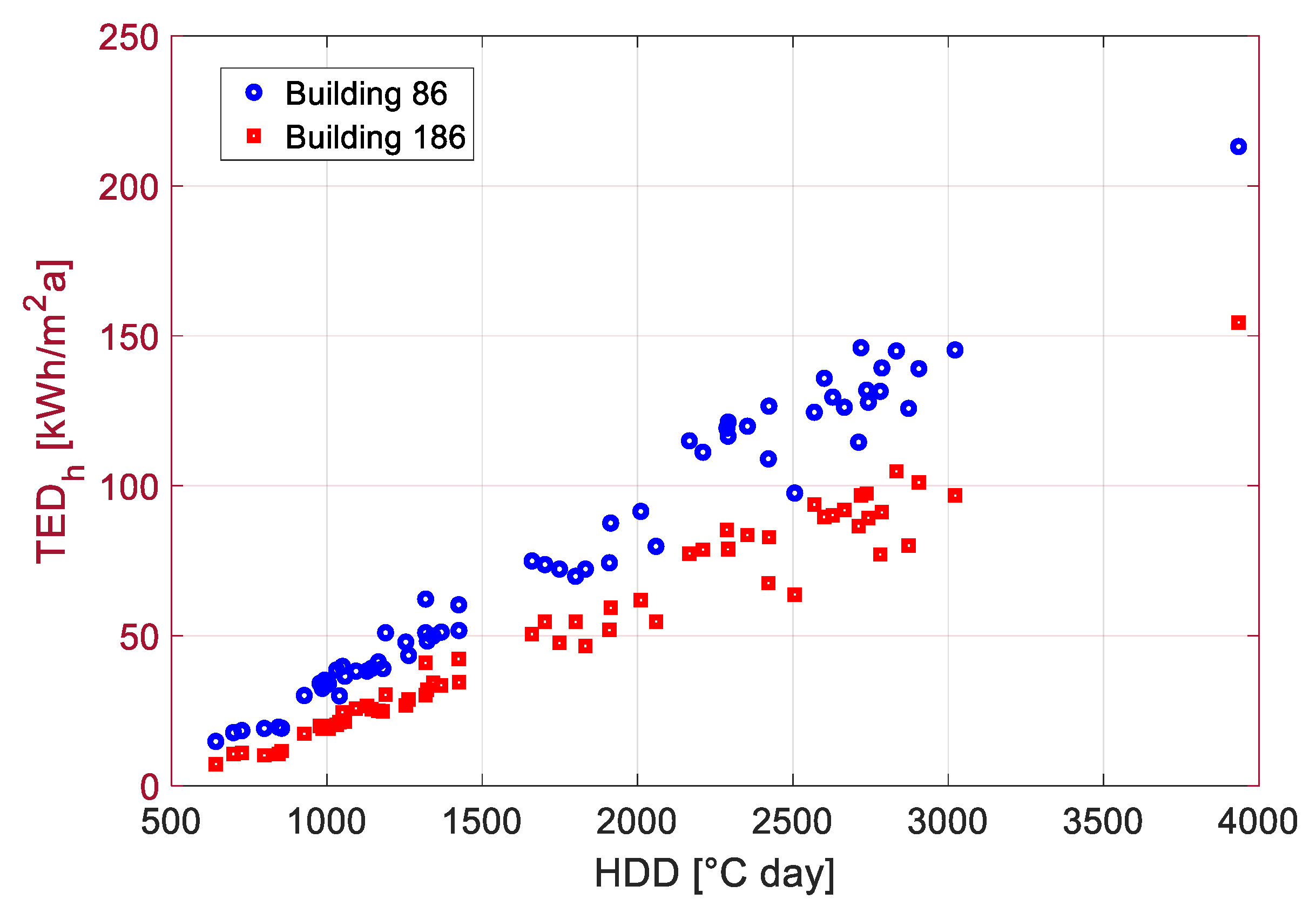
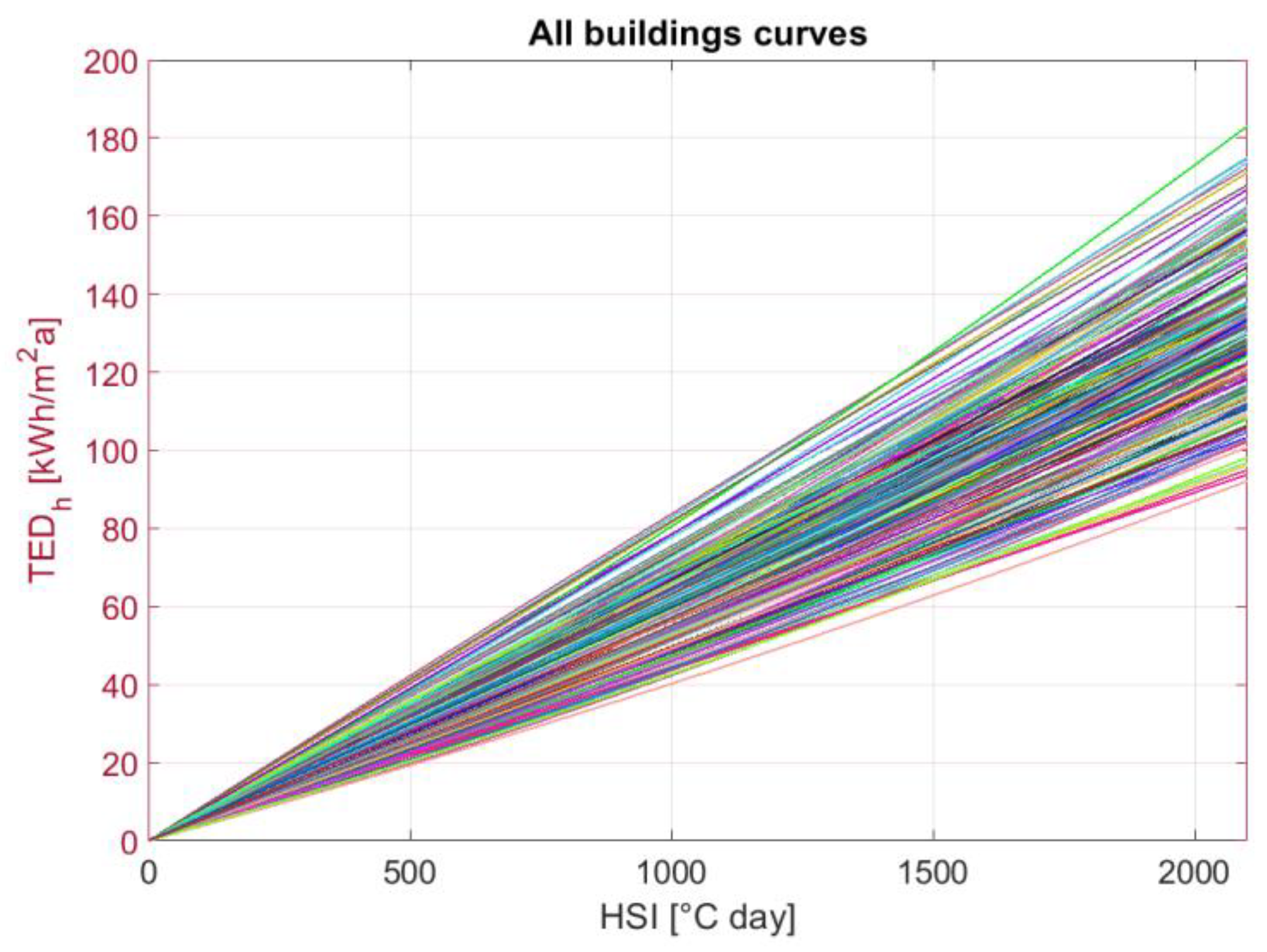
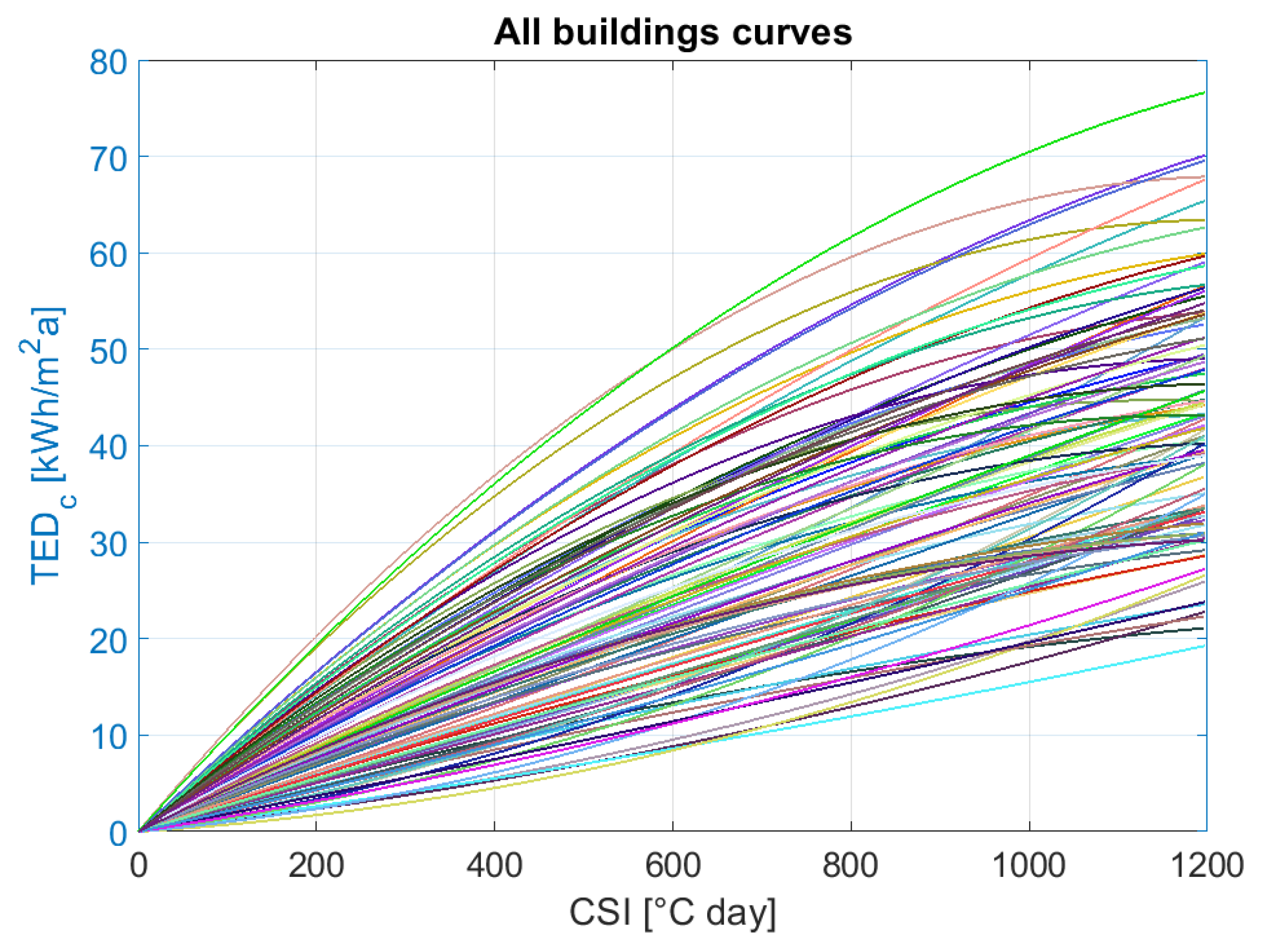

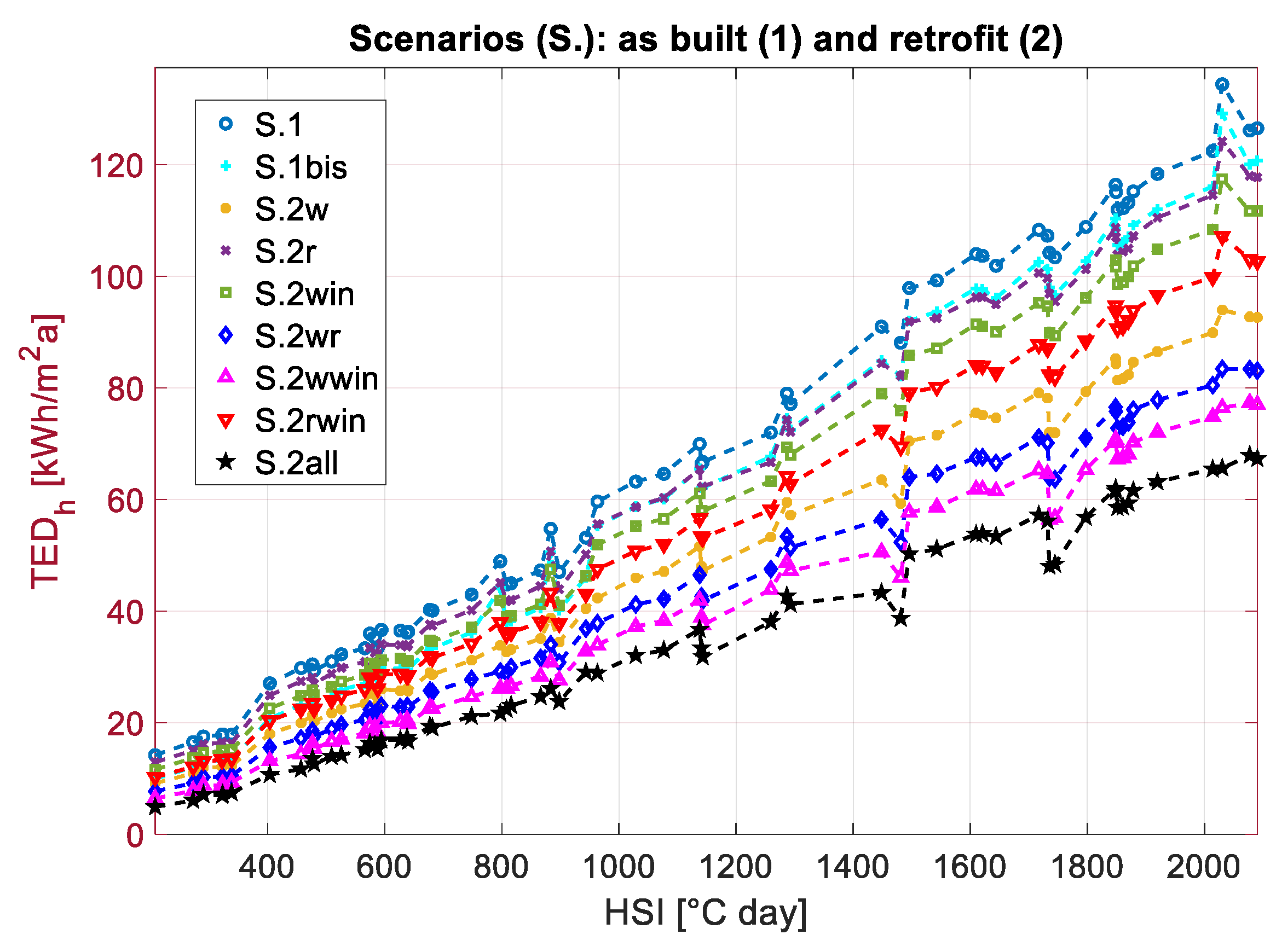


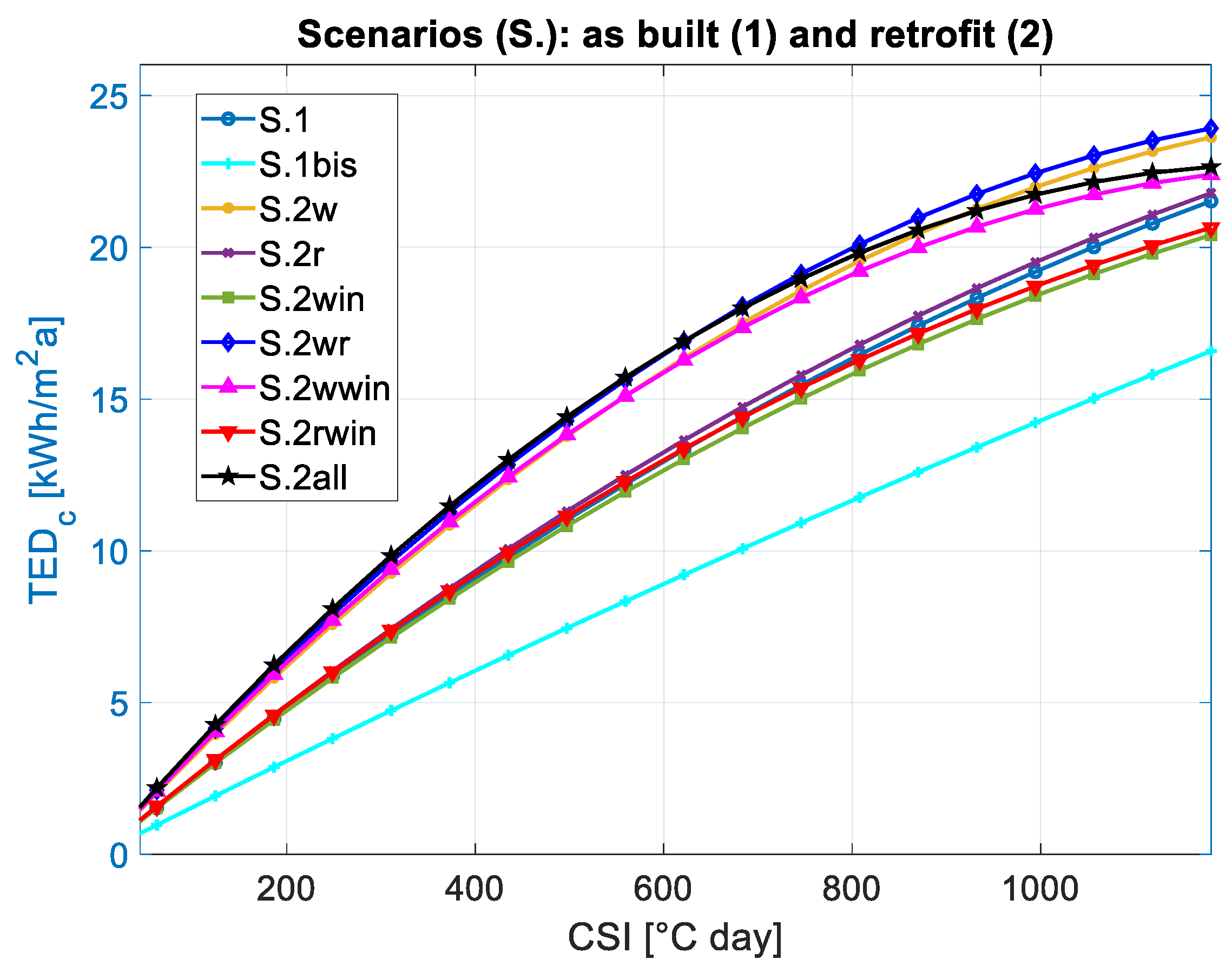
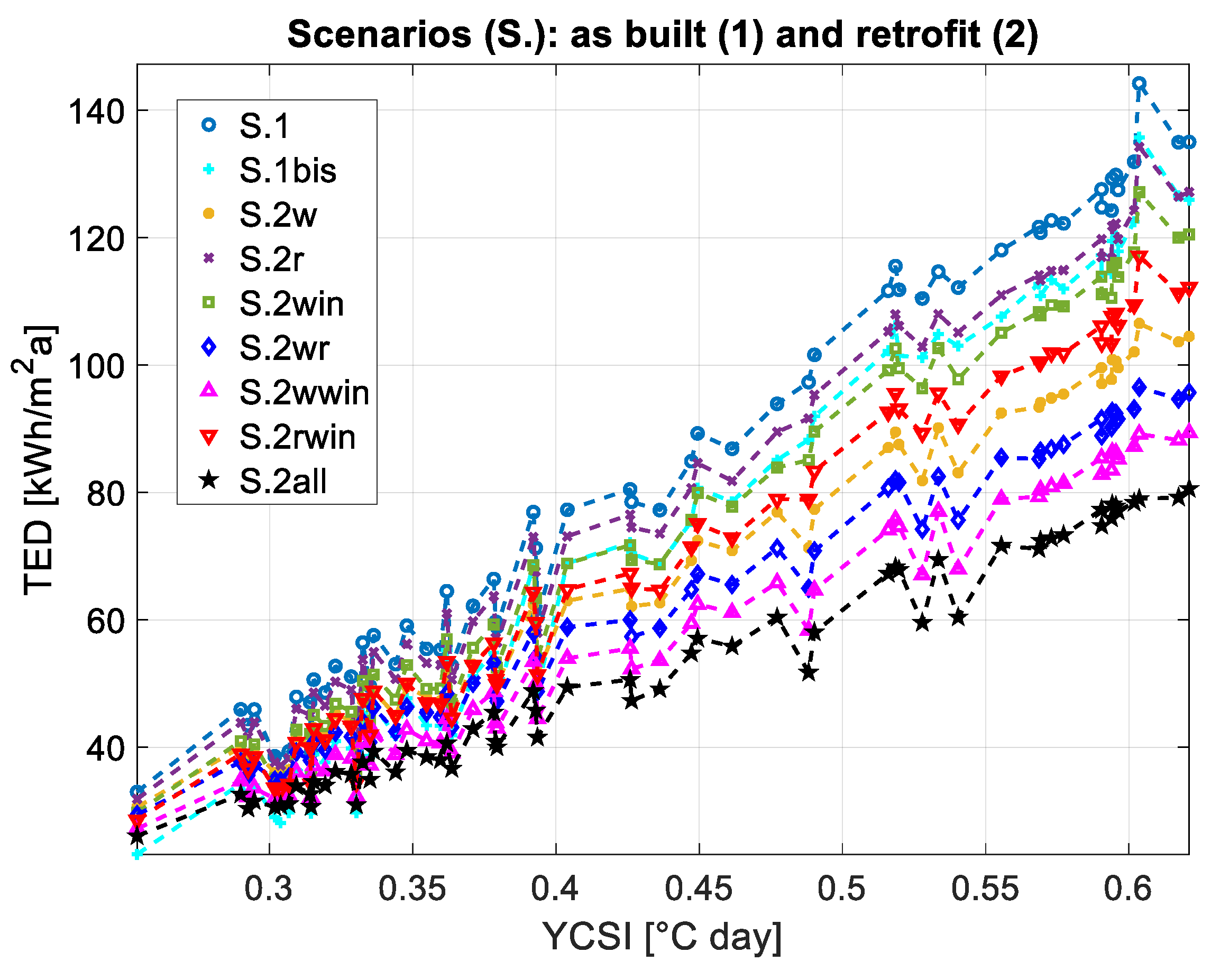
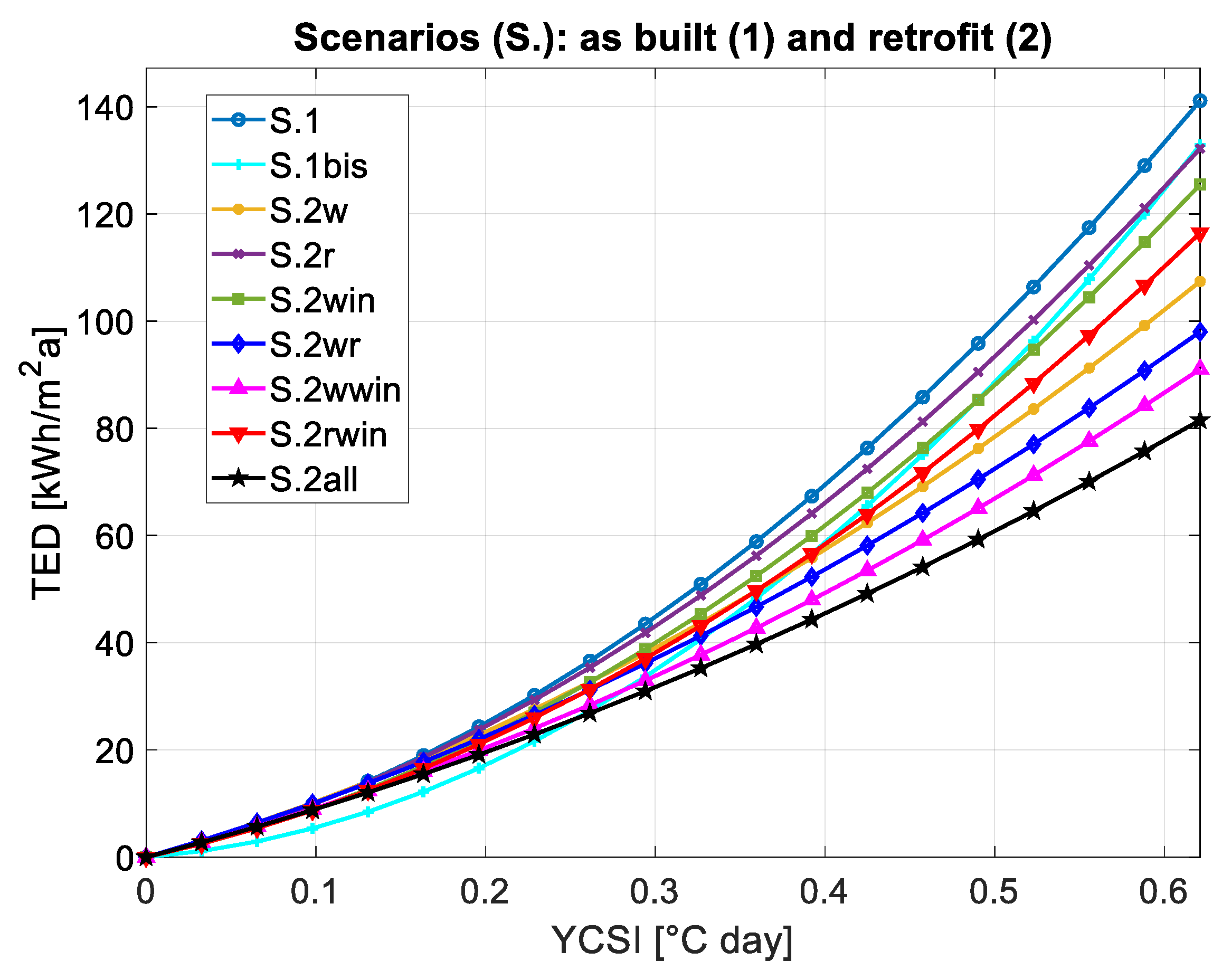
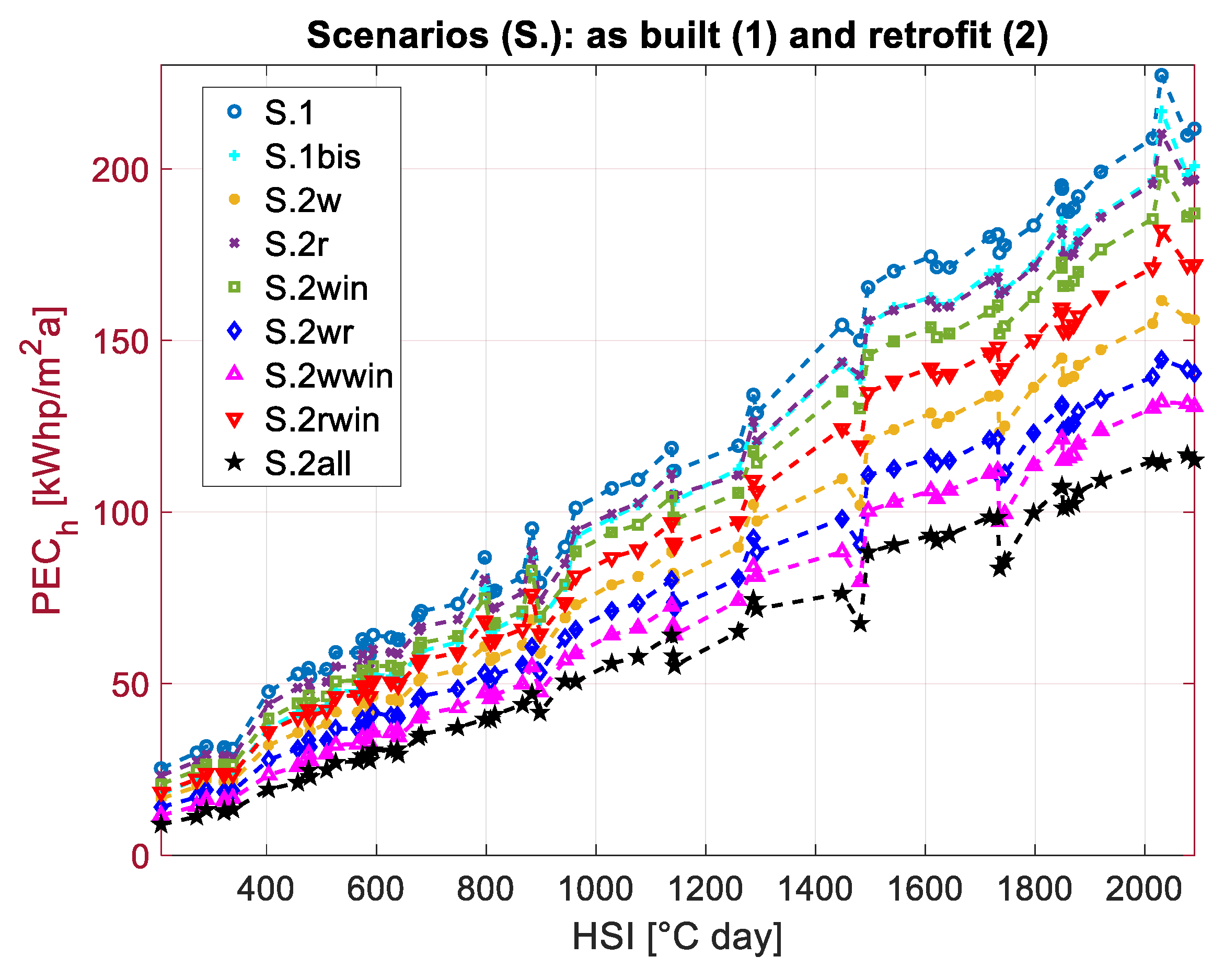
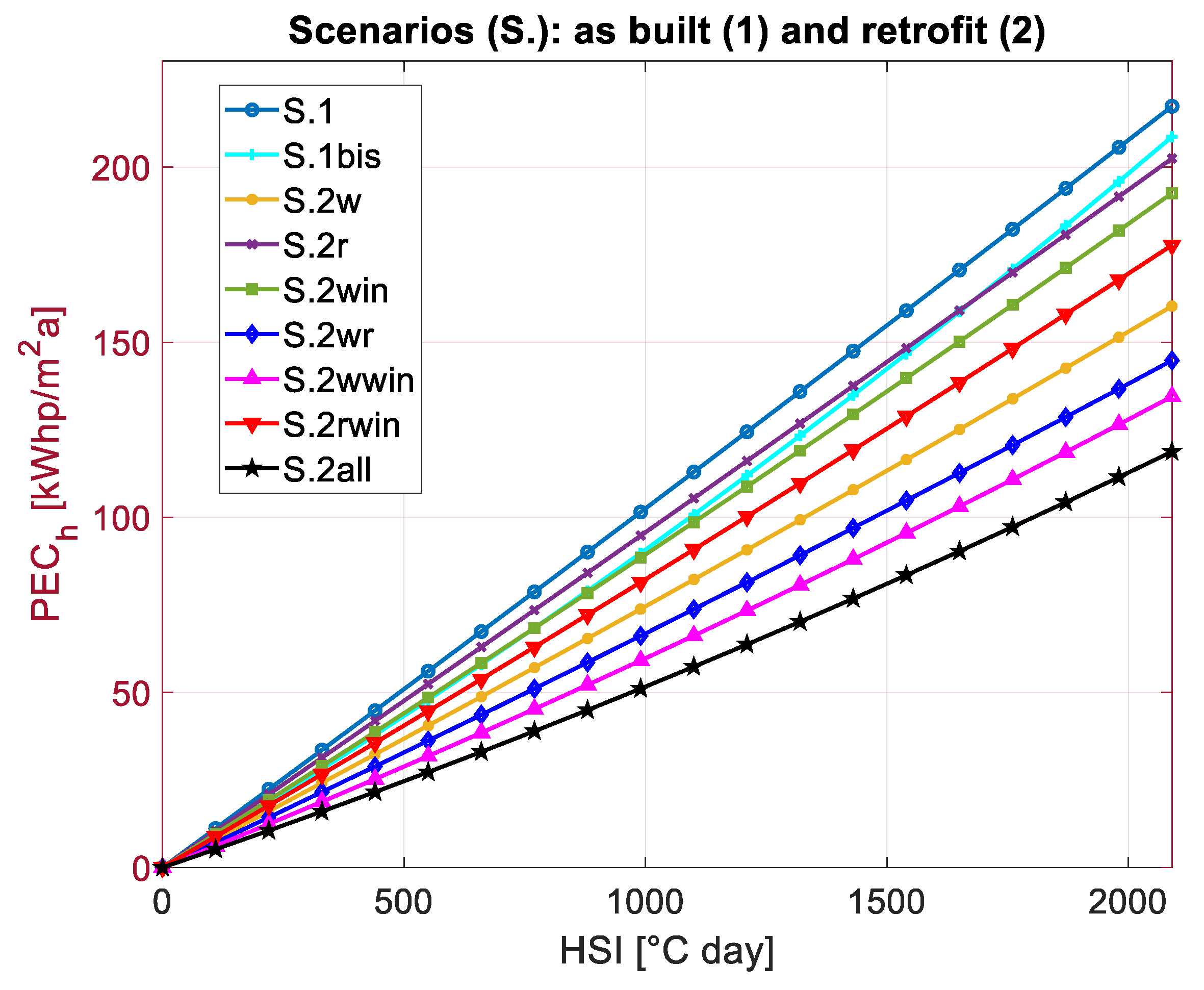

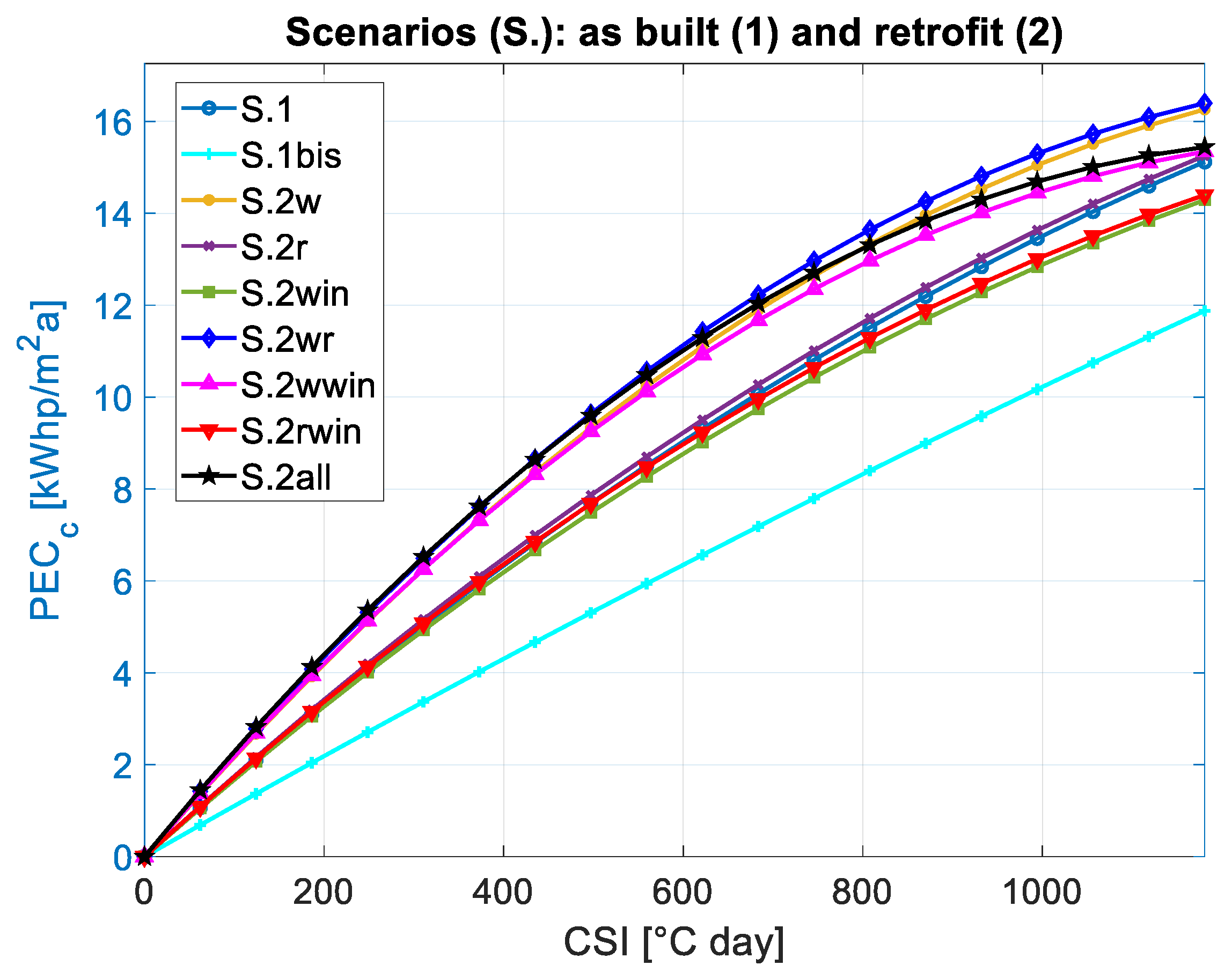
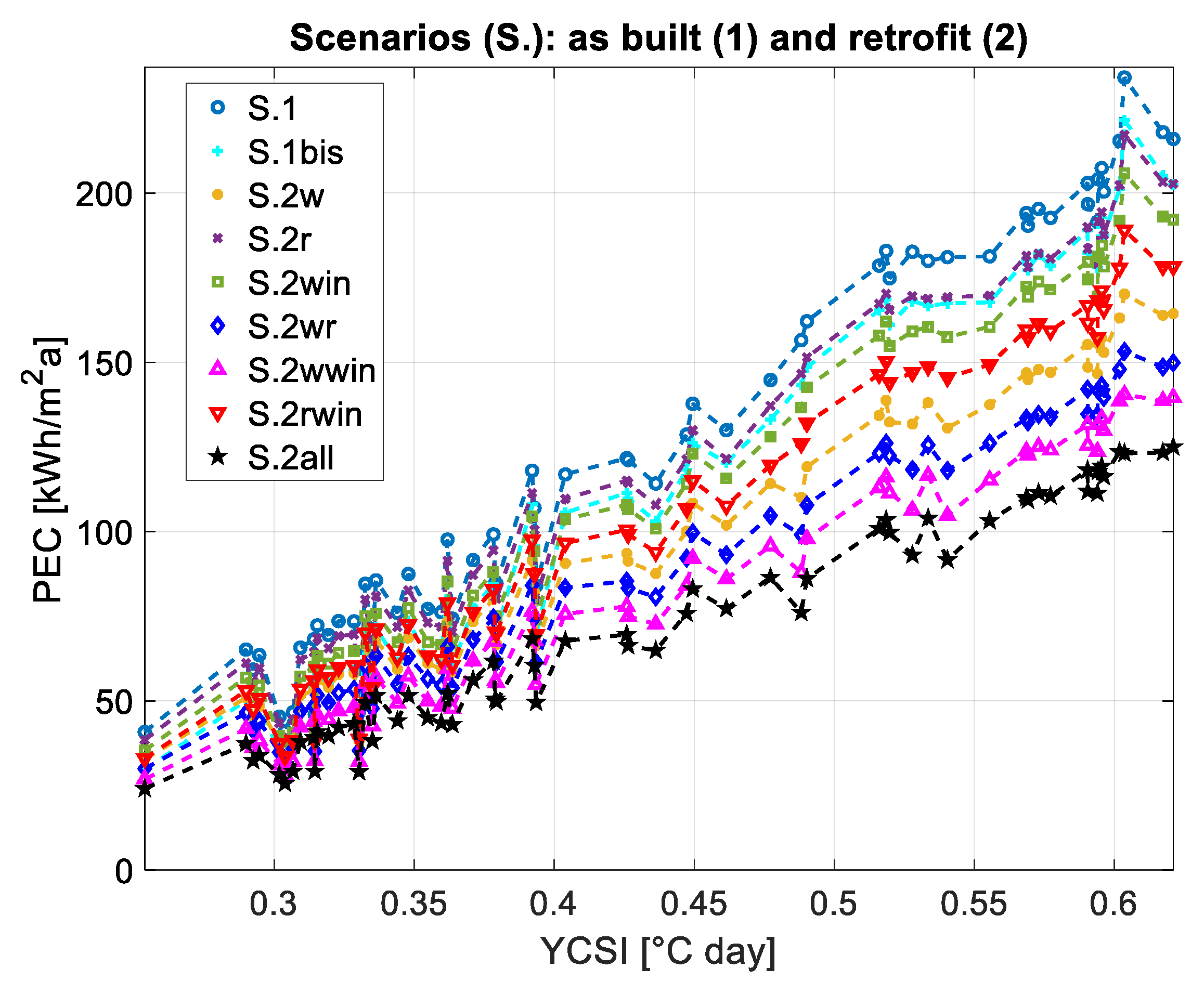

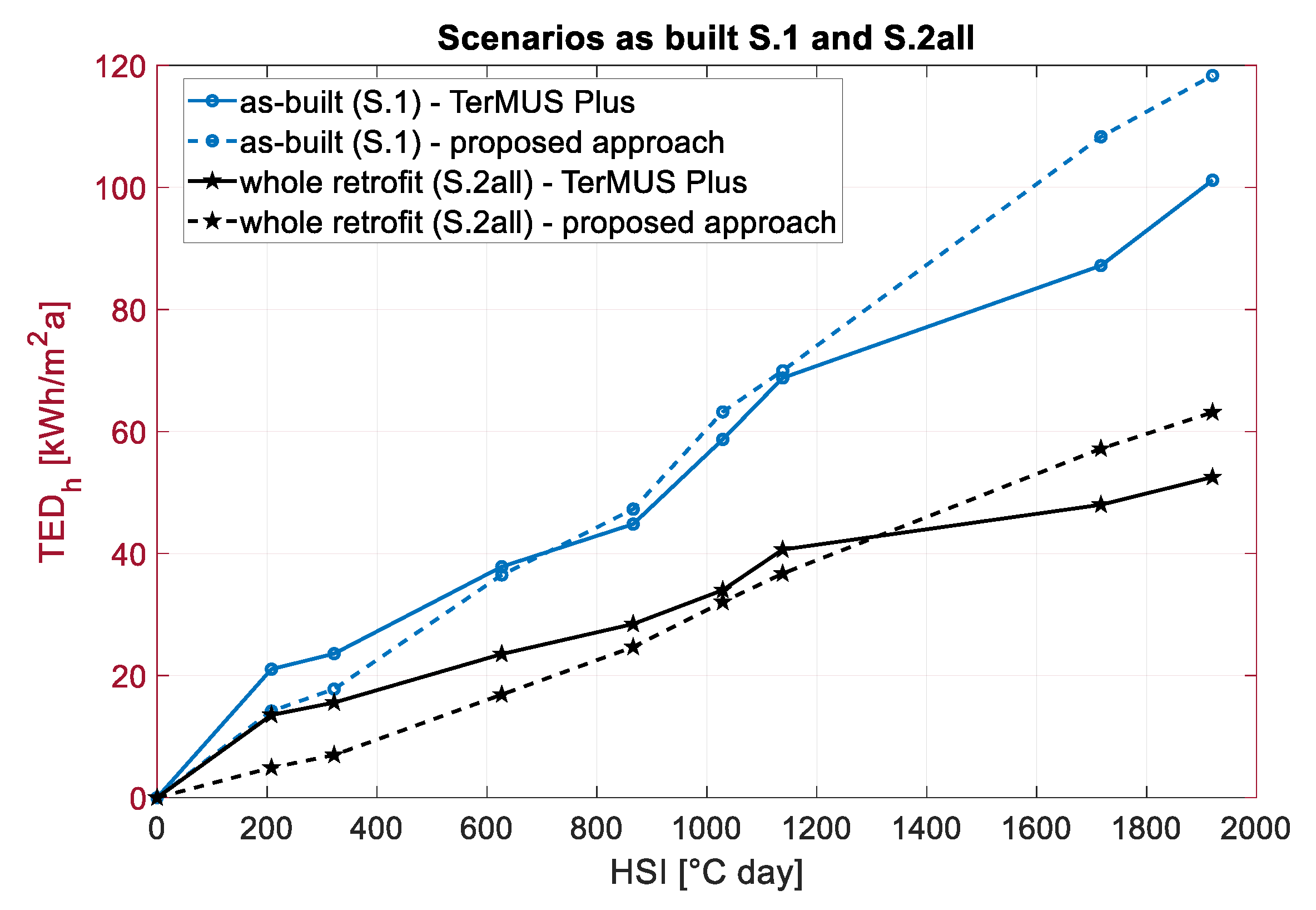
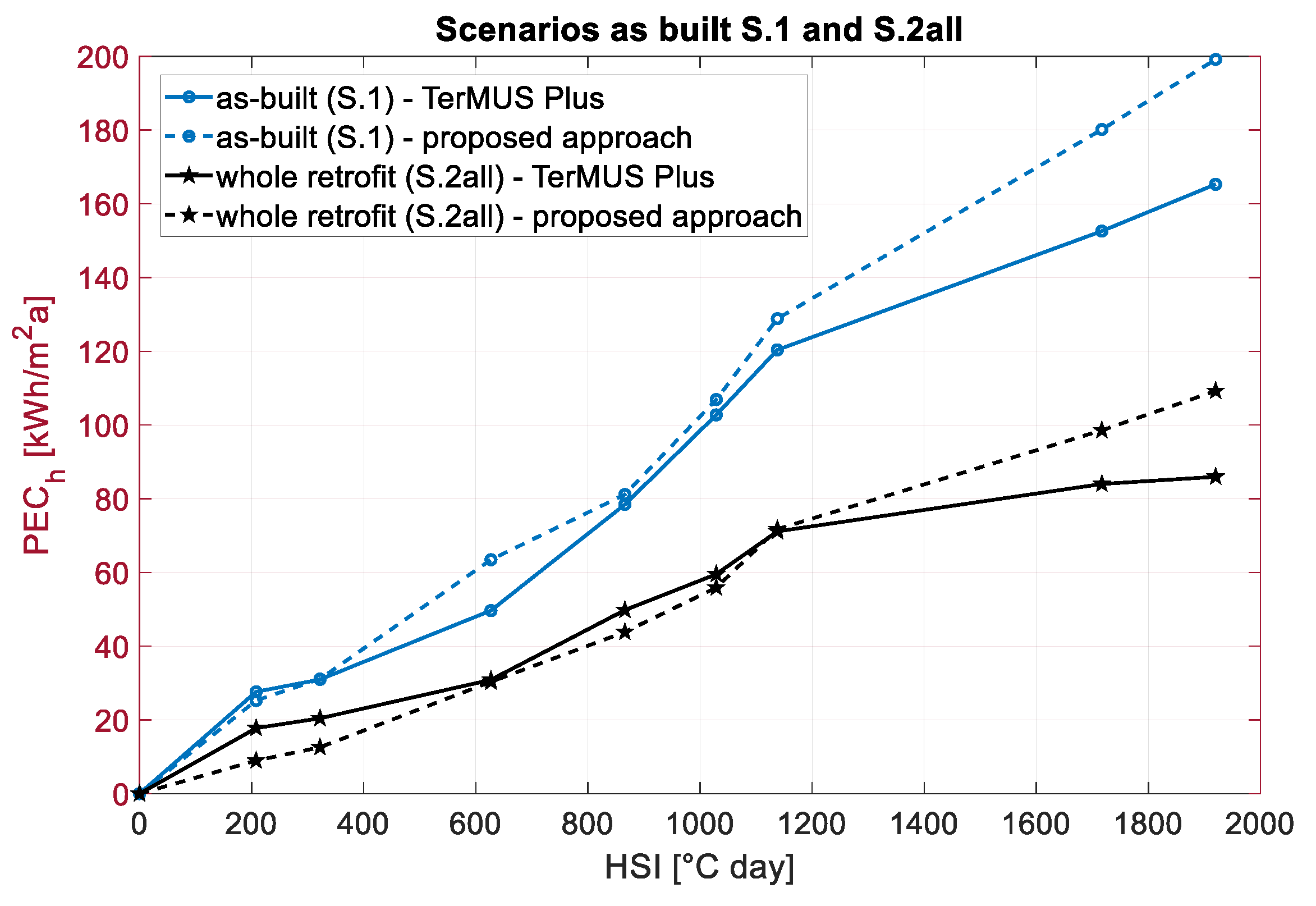
| Building | S/V [m−1] | U Walls [W/m2K] | U Ground-Floor [W/m2K] | U Roof [W/m2K] | U Windows [W/m2K] | Solar Heat Gain Coefficient [-] |
|---|---|---|---|---|---|---|
| Multi-family building | 0.54 | 1.15 | 1.30 | 1.42 | 4.90 | 0.85 |
| Apartment block | 0.46 | 1.10 | 1.30 | 1.42 | 4.90 | 0.85 |
| Variable (i) | Value for RBS-a | Value for RBS-b |
|---|---|---|
| (i1) floors number | 4, 5, 6 | 7, 8, 9 |
| (i2) orientation | angle between building N and true N: 0°, +45°, −45°, 90° | |
| (i3) gross area per floor | from 150 to 350 m2 | From 300 to 500 m2 |
| (i4) S/V | from 0.80*TABULA-value to 1.20*TABULA value [m−1] | |
| (i5) gross height per floor | from 2.80 to 3.80 m | |
| (i6) window-to-wall ratio | from 0.10 to 0.30 | |
| (i7) wall thickness | from 0.20 to 0.35 m | |
| (i8) wall solar absorbance | from 0.10 to 0.90 | |
| (i9) roof solar absorbance | from 0.10 to 0.90 | |
| (i10) wall brick thickness | from 0.18 to 0.25 m | From 0.18 to 0.30 m |
| (i11) k of walls | 0.30, 0.36, 0.43, 0.50 W/m K | |
| (i12) ρ of external walls | 600 kg/m3 for k = 0.30 W/m K, 800 kg/m3 for k = 0.30 W/m K, 1000 kg/m3 for k = 0.43 W/m K, 1200 kg/m3 for k = 0.50 W/m K | |
| (i13) wall insulation thickness | - | |
| (i14) roof thickness | from 0.25 to 0.40 m | |
| (i15) k of roof | 0.43, 0.50, 0.59, 0.72 W/m K | |
| (i16) ρ of roof | 1000 kg/m3 for k = 0.43 W/m K, 1200 kg/m3 for k = 0.50 W/m K, 1400 kg/m3 for k = 0.59 W/m K, 1600 kg/m3 for k = 0.72 W/m K | |
| (i17) roof insulation thickness | - | |
| (i18) ground-floor thickness | from 0.25 to 0.40 m | |
| (i19) k of ground-floor | (see i15) | |
| (i20) ρ of ground-floor | (see i16) | |
| (i21) ground-floor insulation thickness | - | |
| (i22) window type | single-glazed with a wooden frame with U = 4.90 W/m2K and SHGC = 0.85 or double-glazed air-filled with a PVC frame with U = 2.80 W/m2K and SHGC = 0.76 (considering a window replacement probability of 50% for some apartments) | |
| (i23) heating set-point temperature (T) | 19, 19.5, 20, 20.5, 21 °C | |
| (i24) heating efficiency | from 0.60 to 0.90 | |
| (i25) cooling probability | 50% | |
| (i26) cooling set-point T | 25, 25.5, 26, 26.5, 27 °C | |
| (i27) cooling energy efficiency ratio | from 2.00 to 3.00 | |
| (i28) summer ventilation set-point T | 26, 26.5, 27, 27.5, 28 °C | |
| (i29) summer ventilation ACH | from 2 to 6 h−1 | |
| Climatic Zones | HDD [°C Day] Ranges for Each Climatic Zone | Considered Locations | HDD * [°C Day] | ||
|---|---|---|---|---|---|
| B | from 600 | to 900 | |||
| 1/3 of the range | 700 | Palermo-Punta Cinisi | 643 | ||
| 2/3 of the range | 800 | Trapani-Birgi | 799 | ||
| C | from 901 | to 1400 | |||
| 1/3 of the range | 1067 | Lecce-Galatina | 1050 | ||
| 2/3 of the range | 1233 | Roma-Fiumicino | 1342 | ||
| D | from 1401 | to 2100 | |||
| 1/3 of the range | 1633 | Grosseto | 1660 | ||
| 2/3 of the range | 1867 | Ancona-Falconara | 1913 | ||
| E | from 2101 | to 3000 | |||
| 1/3 of the range | 2400 | Bologna-Borgo Pan. | 2423 | ||
| 2/3 of the range | 2700 | Piacenza | 2719 | ||
| Scenario | cv(RMSE) | MAPE | MBE | |||
|---|---|---|---|---|---|---|
| TEDh | PECh | TEDh | PECh | TEDh | PECh | |
| S.1 | 17.3% | 16.3% | 12.7% | 11.4% | −4.0 kWh/m2a | −11.0 kWh/m2a |
| S.2w | 27.9% | 28.0% | 20.3% | 20.1% | −5.9 kWh/m2a | −14.1 kWh/m2a |
| S.2r | 15.3% | 14.1% | 11.5% | 9.10% | −2.1 kWh/m2a | −7.7 kWh/m2a |
| S.2win | 18.2% | 15.9% | 14.5% | 10.9% | −0.5 kWh/m2a | −5.3 kWh/m2a |
| S.2wr | 23.2% | 23.1% | 17.0% | 16.3% | −3.2 kWh/m2a | −9.6 kWh/m2a |
| S.2wwin | 26.1% | 24.8% | 20.2% | 17.2% | −1.0 kWh/m2a | −6.2 kWh/m2a |
| S.2rwin | 16.2% | 12.1% | 15.1% | 10.0% | 2.3 kWh/m2a | −0.4 kWh/m2a |
| S.2all | 24.0% | 20.1% | 22.0% | 15.1% | 1.7 kWh/m2a | −1.5 kWh/m2a |
Disclaimer/Publisher’s Note: The statements, opinions and data contained in all publications are solely those of the individual author(s) and contributor(s) and not of MDPI and/or the editor(s). MDPI and/or the editor(s) disclaim responsibility for any injury to people or property resulting from any ideas, methods, instructions or products referred to in the content. |
© 2023 by the authors. Licensee MDPI, Basel, Switzerland. This article is an open access article distributed under the terms and conditions of the Creative Commons Attribution (CC BY) license (https://creativecommons.org/licenses/by/4.0/).
Share and Cite
De Masi, R.F.; Mauro, G.M.; Ruggiero, S.; Villano, F. Predicting Building Energy Demand and Retrofit Potentials Using New Climatic Stress Indices and Curves. Energies 2023, 16, 5861. https://doi.org/10.3390/en16165861
De Masi RF, Mauro GM, Ruggiero S, Villano F. Predicting Building Energy Demand and Retrofit Potentials Using New Climatic Stress Indices and Curves. Energies. 2023; 16(16):5861. https://doi.org/10.3390/en16165861
Chicago/Turabian StyleDe Masi, Rosa Francesca, Gerardo Maria Mauro, Silvia Ruggiero, and Francesca Villano. 2023. "Predicting Building Energy Demand and Retrofit Potentials Using New Climatic Stress Indices and Curves" Energies 16, no. 16: 5861. https://doi.org/10.3390/en16165861
APA StyleDe Masi, R. F., Mauro, G. M., Ruggiero, S., & Villano, F. (2023). Predicting Building Energy Demand and Retrofit Potentials Using New Climatic Stress Indices and Curves. Energies, 16(16), 5861. https://doi.org/10.3390/en16165861









